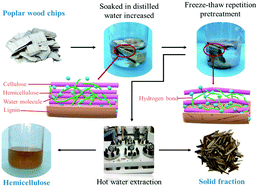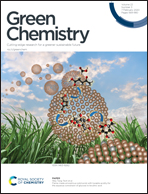Freeze–thaw repetition as an auxiliary method to promote efficient separation of hemicellulose from poplar†
Abstract
The application of freeze–thaw repetition as a pretreatment method in hydrothermal treatment and green upgradation of poplar biomass has been investigated. The process was carried out at different freeze–thaw repetition (1–6 times) and freezing temperatures (−4 °C to −70 °C). Poplar chips were freeze-thawed 4 times at −20 °C, and then hydrolyzed by hot water for 1 h at 170 °C, consequently a hemicellulose yield of 85.87 mg g−1 was obtained, showing an increase of 32.25% over that of untreated poplar chips. Besides, freeze–thaw repetition pretreatment resulted in lowered molecular weight and enhanced concentration of monosaccharides. The morphology and chemical structure of all samples were also carefully addressed, indicating that freeze–thaw repetition could create irregular micro slits and pores, thus increasing fibrous cell wall debris, which significantly contributed to the dissolution rate of hemicellulose. This study demonstrates a feasible and effective strategy to predominately extract hemicellulose from raw biomass for promising biorefinery.



 Please wait while we load your content...
Please wait while we load your content...